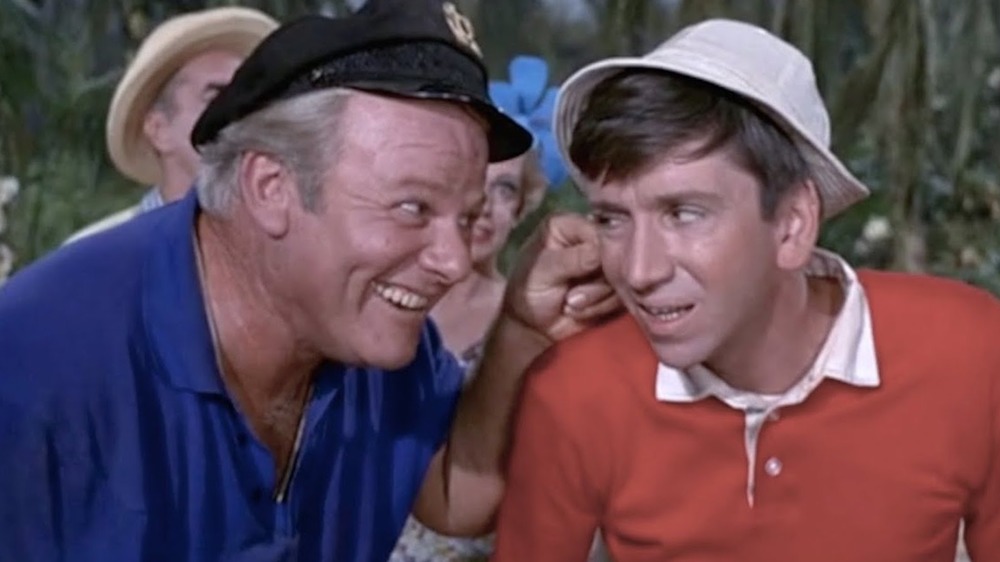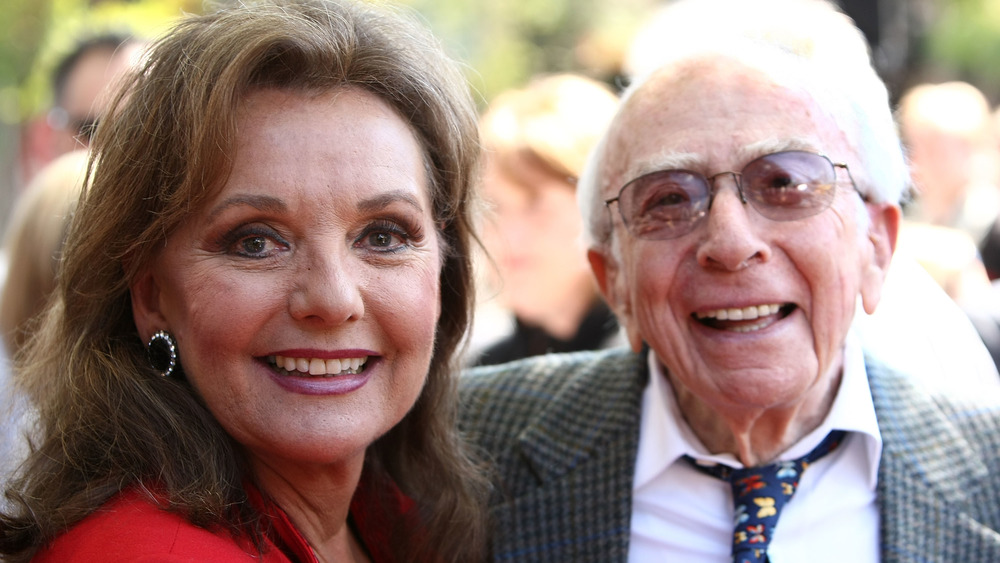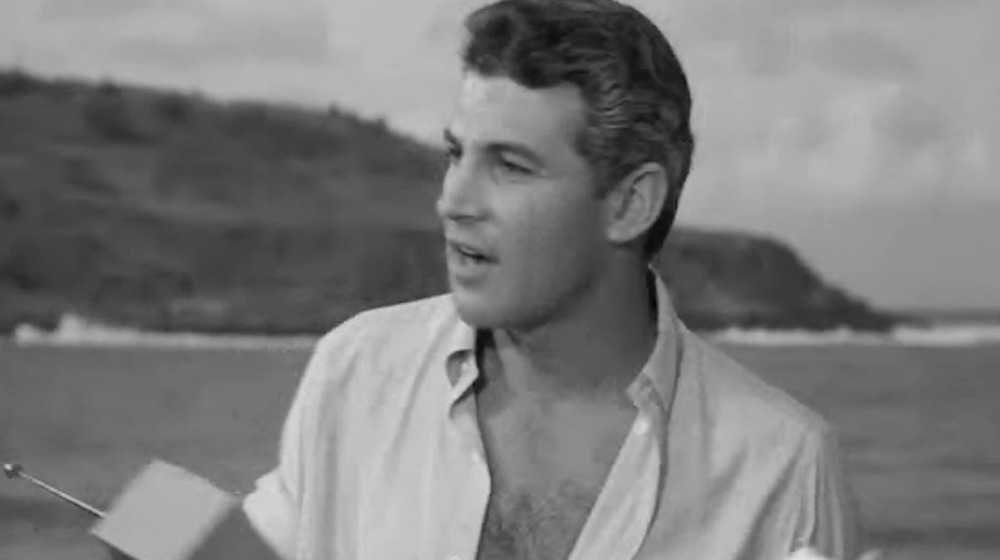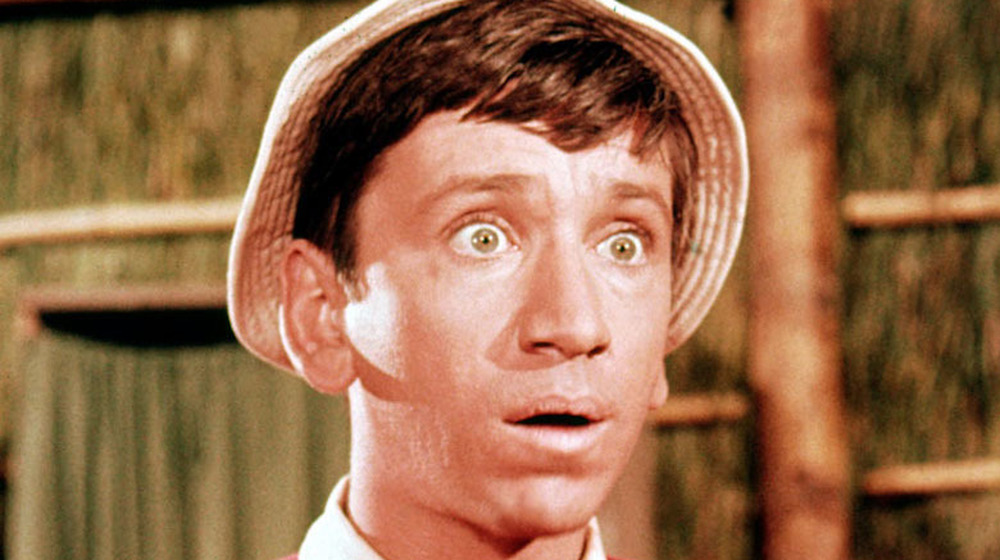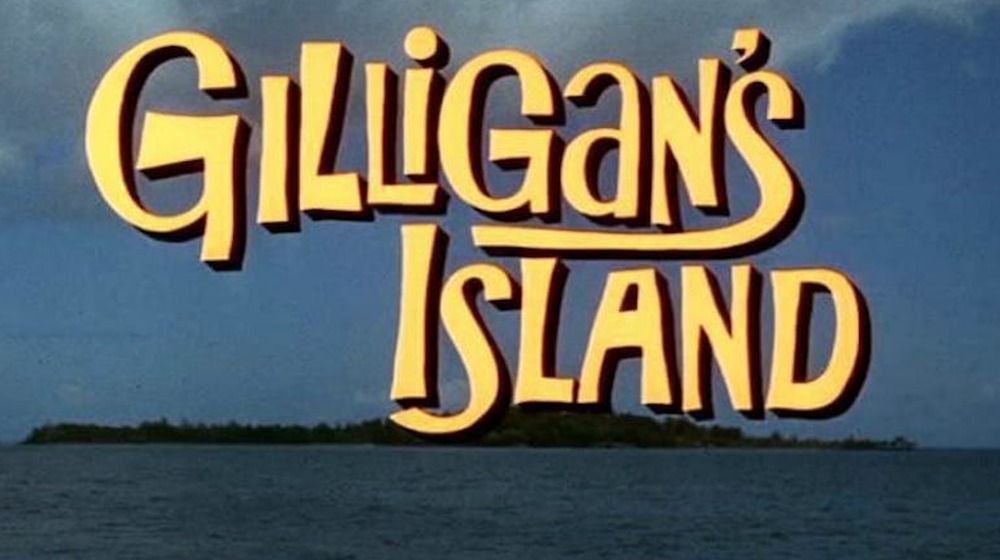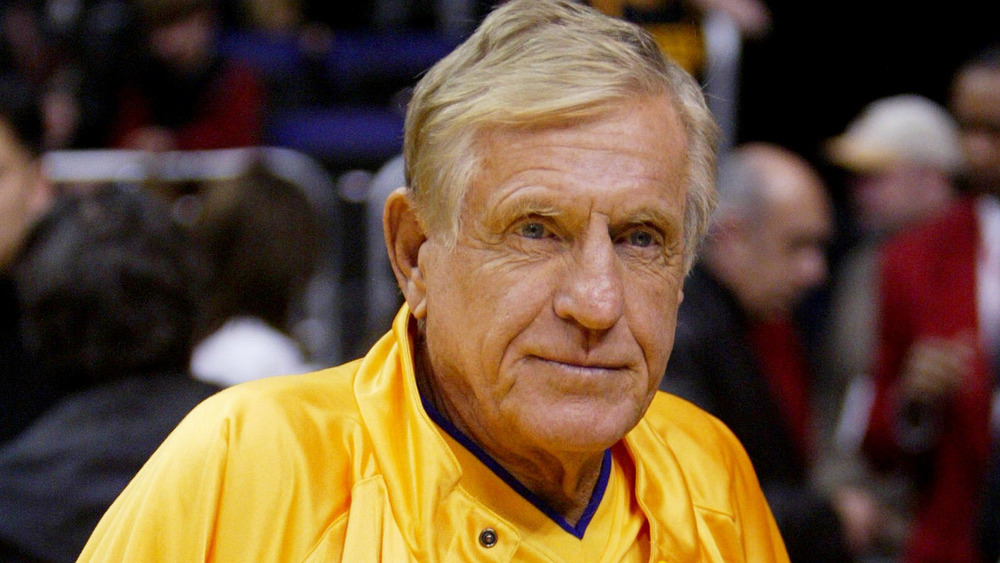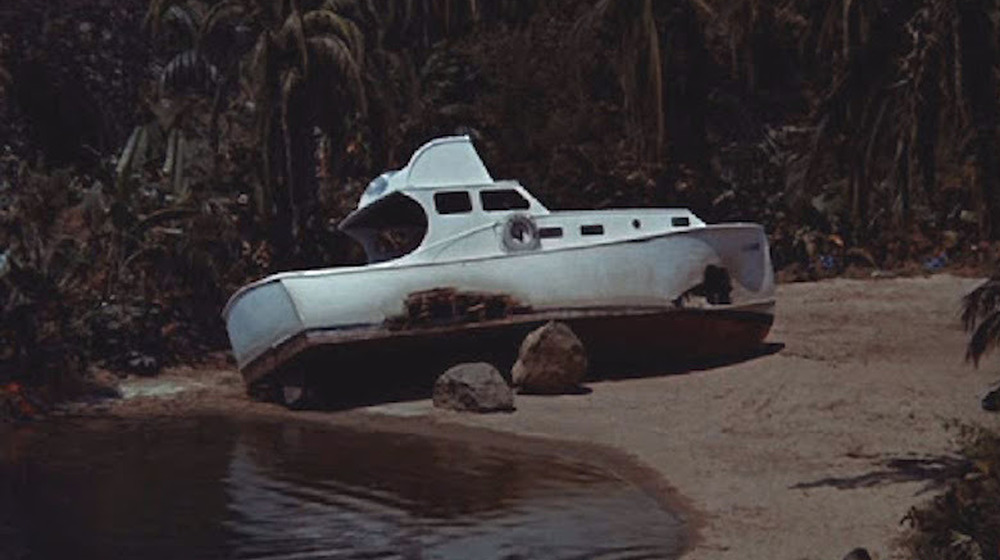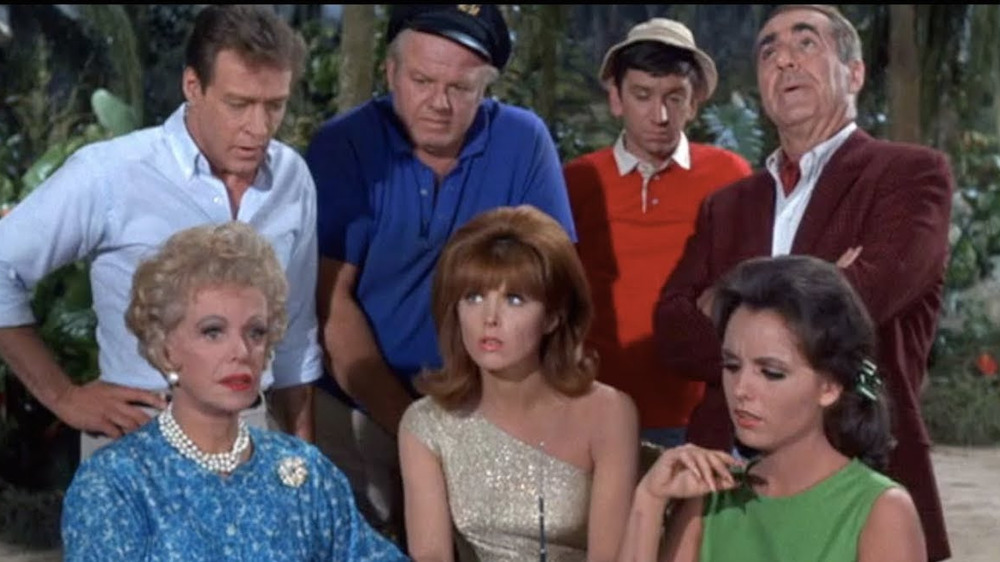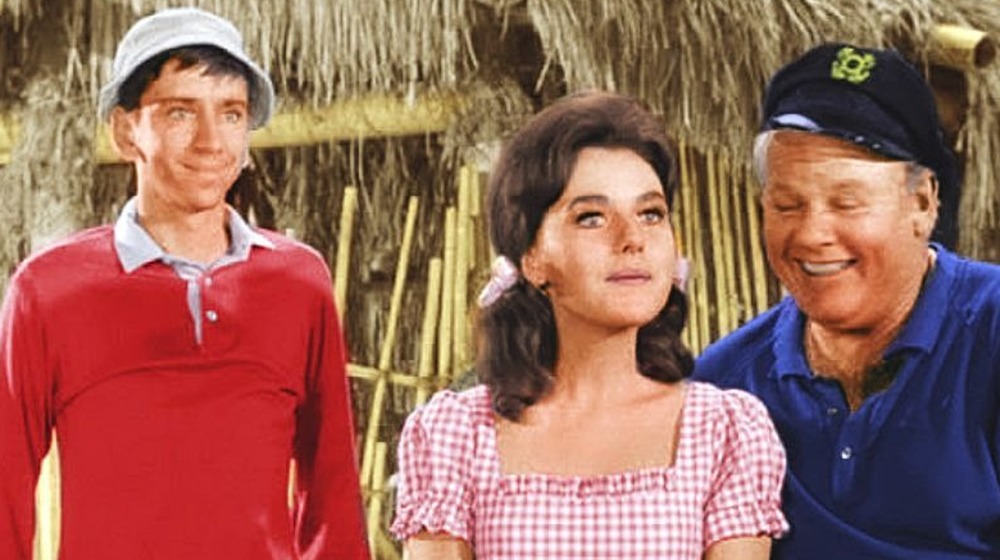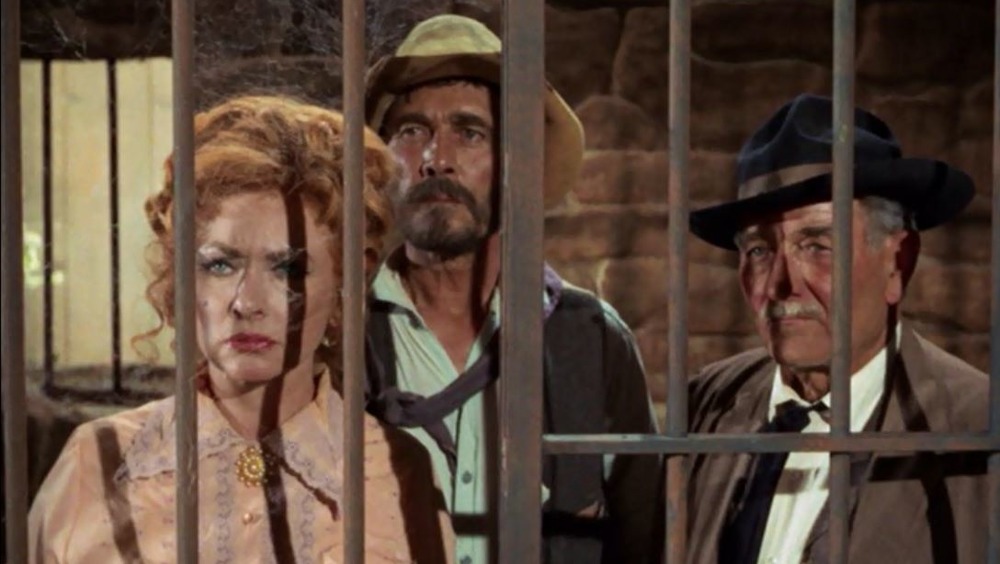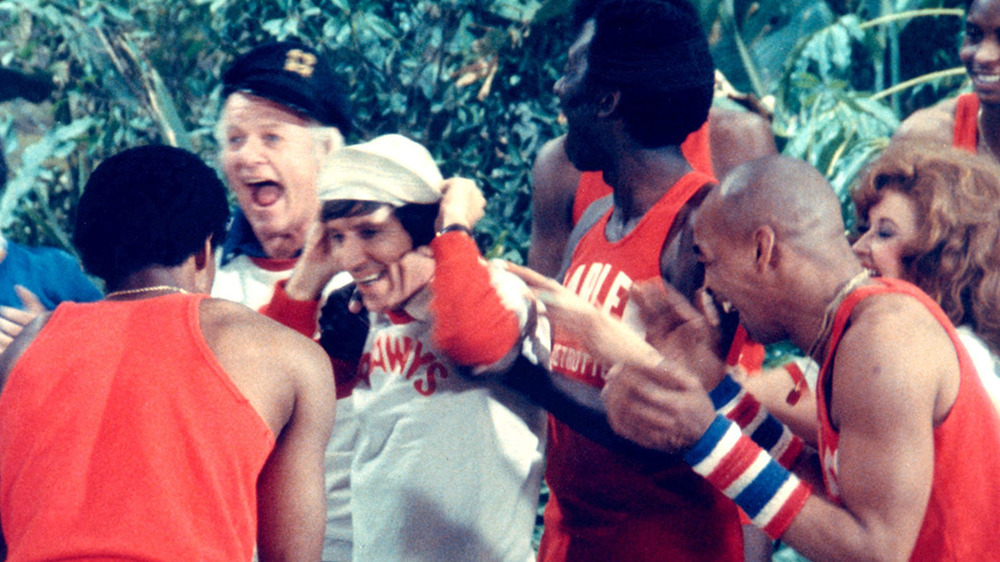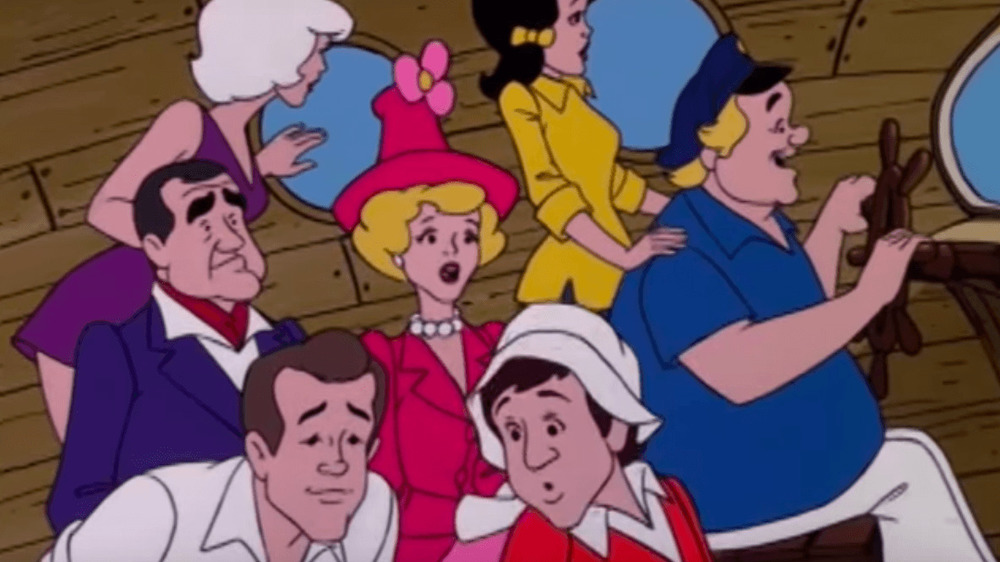The Untold Truth Of Gilligan's Island
One part slapstick, one part survival show, one part buddy comedy, and all parts goofy '60s classic, Gilligan's Island is one of the most popular and well-known situation comedies of all time. The 1964-1967 sitcom concerns seven castaways — five passengers and two crew members — who plan to embark on a relaxing, casual pleasure cruise. But that three-hour tour quickly turns disastrous when the weather starts getting rough and sends the S.S. Minnow out to sea, where it comes to rest on a remote island not found on any map but which offers plenty of coconuts on which the shipwrecked seven can survive.
Those left to fend for themselves and each other are a disparate bunch. There's bumbling first mate Gilligan (Bob Denver), the irascible Skipper (Alan Hale, Jr.), tycoon Thurston Howell III (Jim Backus), his wife and true love Lovey (Natalie Schafer), screen siren Ginger (Tina Louise), the inventive Professor (Russell Johnson), and plucky Mary Ann (Dawn Wells).
So just sit right back and you'll hear a tale, a tale of a fateful sitcom. Here's the untold truth of Gilligan's Island.
Creator Sherwood Schwartz was inspired by a college professor
The premise of Gilligan's Island is straightforward — seven people from different walks of life are forced to rely on each other for their survival after being stranded on a remote tropical island. It's basically the same idea explored by later shows like Survivor and Lost, but for the mid-1960s, it was high concept and bizarre when compared to the landlocked family comedies of the era, such as The Dick Van Dyke Show, My Three Sons, and The Andy Griffith Show.
It's a comedy about the aftermath of a traumatic event, and sprang from a thought that creator Sherwood Schwartz had been turning over in his head for years. During a class on public speaking at New York University, as he recalled in Inside Gilligan's Island, Schwartz and his fellow students were tasked with writing a one-minute speech about the one item they would take with them if stranded on an island. Schwartz became a TV writer and landed jobs on several shows, but when it came time to come up with his own comedy, he went back to the idea of a remote island, and how it could be sociologically interesting to present a varied group of people stuck together, calling it "a social microcosm and a metaphorical shaming of world politics in the sense that when necessary for survival, yes we can all get along."
The lost pilot of Gilligan's Island
Even though creator Sherwood Schwartz thought about the ideas and themes behind Gilligan's Island for a long time, he didn't exactly nail the concept on the first try. On November 22, 1963, Gilligan's Island shot its pilot episode, which was sent to CBS for consideration to become a regular series for the following fall. While the network did order more Gilligan's Island episodes, the show that would enter production looked a lot different than the one suggested by the pilot.
According to TV Obscurities, the characters of Ginger and Mary Ann, respectively a movie star and Midwestern farmer's daughter, originally took the form of secretaries named Ginger and Bunny, played by Kit Smythe and Nancy McCarthy instead of Tina Louise and Dawn Wells. The Professor was as smart and smug as he'd wind up in the long haul, but portrayed by actor John Gabriel instead of Russell Johnson. Even the inciting incident was a little off — the castaways got lost on a "six-hour ride," not a "three-hour tour."
That pilot then disappeared. After reading about the episode in a Gilligan's Island book in the early 1990s, an employee of cable station TBS went looking for it, and made some calls to the corporate office, Turner Entertainment. The negatives, which had sat untouched for 30 years, were found in the archives of the Turner-owned MGM/United Artists film library. TBS then aired that episode, for the first time, in October 1992.
Gilligan could have shared the island with a dinosaur
Had Hunt Stromberg, Jr., the executive in charge of new programming at CBS in the mid-1960s, been able to execute his suggestion, Gilligan's Island would have had an eighth regular member of the cast — a native of the island, not another person left stranded by shipwreck. In his book Inside Gilligan's Island, creator Sherwood Schwartz recalled watching the show's pilot episode with Stromberg. When they got to the part where Gilligan climbs a tree to survey the island in search of resources or signs of life, Stromberg excitedly suggested that the character should find a dinosaur, which Gilligan could then walk around on a leash and treat like a pet. "Just picture it!" Stromberg reportedly said. "It's our answer to Mr. Ed!"
Because a high-ranking CBS executive suggested it, Schwartz and his fellow producers had to dutifully entertain the idea of putting a dinosaur into their show. They even inquired with Disney, which had just developed a technique to seamlessly place animated figures into live-action footage. What killed the dinosaur on Gilligan's Island: It was way out of the show's budget.
The story behind the Gilligan's Island theme song
Even if one's recollections of Gilligan's Island are foggy at best, one can at least probably sing the show's theme song in full. Not only is it supremely catchy (and perhaps deeply embedded in the collective psyche from decades of reruns), but it lays out the name and distinguishing characteristic of all of the comedy's characters succinctly and clearly explains the show's premise — a necessity, because Gilligan's Island had a much more complicated set-up than, say, Leave it to Beaver.
Folk acts like the Kingston Trio were big in the mid-1960s, and they'd often perform on the TV music show Shindig! Among them: a trio called the Wellingtons. After CBS ordered changes to the Gilligan's Island pilot, creator Sherwood Schwartz decided to come up with a theme song to explain the show, and wrote the folky "The Ballad of Gilligan's Island" with composer George Wyle. The session to record the tune was arranged last-minute and with subpar equipment, but it didn't matter — CBS liked the song and agreed to use it.
Schwartz slightly reworked the song for season 2, and a group called the Eligibles recorded the near-soundalike version, although the Wellingtons did make it onto Gilligan's Island proper. They guest-starred as the Mosquitoes, a Beatles-esque band that turns up on the island.
Some famous people almost wound up on Gilligan's Island
The actors who ultimately won the seven roles of the castaways on Gilligan's Island became forever and most closely associated with their work on the 1964-1967 sitcom. With the exception of The Many Lives of Dobie Gillis veteran Bob Denver, none of the performers were household names before being sent off to that fictional island, and some weren't even slated to be part of the original cast.
Jerry Van Dyke, a TV veteran and four-time Emmy nominee for Coach, was urged by his agency into signing on. "That's the joke: I turned it down and took My Mother the Car," he told Popdose, referring to TV Guide's pick for the worst scripted show ever made. Tootsie and 9 to 5 star Dabney Coleman bombed his screen test to play the Professor, while All in the Family legend Carroll O'Connor just narrowly missed out on the chance to play the Skipper. Former bombshell Jayne Mansfield passed on the opportunity to play Ginger, the Movie Star, while fellow screen vixen Raquel Welch lost the role of Mary Ann to Dawn Wells.
The joke behind the Minnow wasn't lost
The name of the ship on Gilligan's Island, the one that got tossed around by waves and lost at sea only to wash up on a tiny isle, is a pretty good joke that works on multiple levels. The tiny vessel with space for seven is called the S.S. Minnow, appropriately named after a tiny, easily overwhelmed type of fish. It just so happens that "minnow" is a nearly identical word to "Minow," the last name of 1960s-era Federal Communications Commission chairman Newton Minow.
In 1961, the newly appointed regulator gave a speech to the National Association of Broadcasters in which he insulted the medium of television, labeling it a "vast wasteland" of insignificant, disposable, and even harmful content. The speech made waves in the TV industry. "The shocking aftermath of that designation of responsibility by Mr. Minow and the FCC gave ABC, CBS, and NBC absolute authority over everything that comes into your living room on network television," Gilligan's Island creator Sherwood Schwartz wrote in Inside Gilligan's Island. Schwartz's minor but pointed act of rebellion: He named the ineffectual ship on his sitcom after Minow.
A creepy legend about Gilligan's Island is true
Lists of seven items are a recurring theme in history, religion, and culture. Ancient Rome was built on seven hills, there were "Seven Wonders" of the world at one point, and there are "seven deadly sins," universally understood to comprise the most damaging and damning acts known to man. Another famous seven: that's how many castaways were stranded in paradise on Gilligan's Island. It's just too delicious and coincidental to ignore that the number of deadly sins corresponds with the amount of characters on a goofy, innocuous '60s sitcom. That led to a rumor, if not urban legend, that each of the seven deadly sins was perfectly represented by a different Gilligan's character, and that the island itself represented Hell — where they were placed due to their transgressions, and from which they could never escape.
Amazingly, according to NPR, Gilligan's Island creator Sherwood Schwartz admitted that the "seven deadly sins" aspect, at least, was actually true. The characters and their fatal flaw are as follows: the smarty-pants Professor was guilty of pride, wealth-accumulating Mr. Howell was covetous, Ginger was lusty, Mrs. Howell suffered from anger, the Skipper engaged in gluttony, Mary Ann represented envy, and lazy Gilligan was the embodiment of sloth.
Bob Denver stood up for the rest
Gilligan's Island has one of the most memorable theme songs (and opening sequences) in TV history, although it changed ever so slightly following the show's first season. After explaining how five passengers and two crew members wound up on an uncharted desert isle, cast members were introduced with their character name or description — Gilligan, the Skipper, the "Millionaire," his wife, the "Movie Star" — and then the singers abruptly uttered "and the rest," with no by-name intro for either the Professor or Mary Ann. In subsequent seasons, however, the song ends with an acknowledgment of the sixth and seventh castaways and shots of actors Russell Johnson and Dawn Wells.
According to TV Series Finale, Tina Louise had a clause in her contract dictating that she got the final billing in the credits, explaining why she (Ginger, the "Movie Star") was the last named actor, followed by "and the rest." But Bob Denver, the real star of Gilligan's Island, had a clause in his contract that apparently superseded Louise's. He could choose the billing and asked CBS to add Johnson and Wells. The network said no to that, so Denver asked for last billing. Since it would be odd to list the title character last, CBS relented and produced a new credit sequence acknowledging "The Professor and Mary Ann."
Gunsmoke killed Gilligan's Island
While it was never a critical hit or nominated for an Emmy Award, viewers really enjoyed Gilligan's Island. It was a top 25 show in each of its first two seasons before slipping to 47th place in year three. Despite the low ranking, it still held a 30 "share," meaning 30 percent of all TV viewers on Mondays at 7:30 p.m. tuned into Gilligan's Island. At any rate, the numbers were good enough to justify renewing the sitcom for a fourth season.
But then Gunsmoke got in the way. According to Ben Costello's Gunsmoke: An American Institution (via Tulsa World), CBS cancelled the once-popular western in early 1967 after 12 seasons, leaving it off the fall schedule. Gilligan's Island cast member Alan Hale, Jr. (The Skipper) also appeared on that show, and he offered his angry sympathies to Gunsmoke writer Paul Savage. He complained that a show of such stature should continue, and that if any CBS show should go it was "that turkey" he starred on – Gilligan's Island. As it turned out, a CBS executive had decided to get rid of Gunsmoke while CBS chairman William S. Paley was on vacation. When Paley was back at his desk, he un-canceled Gunsmoke – his wife's favorite show – and moved it to a new night, Mondays, displacing Gilligan's Island right off the air.
That time Gilligan met the Harlem Globetrotters
Because Gilligan's Island was prematurely canceled, it didn't end with closure — viewers were left to wonder if the castaways were ever rescued. Reruns of the show proved to be such a perpetual and beloved hit in syndication that there remained substantial interest in a Gilligan's Island update by the late 1970s. In the 1978 made-for-TV movie Rescue from Gilligan's Island, the castaways build a giant raft to escape the wrath of a tsunami on the island, whereupon they're finally discovered and return to civilization. By the end of the movie, however, they're back on the old island, setting up the events of the 1979 TV film The Castaways on Gilligan's Island, where they're stranded for a while until they decide to use Thurston Howell III's money to turn it into a luxury resort.
This new Gilligan's Island trilogy concluded in 1981 with the made-for-TV film The Harlem Globetrotters on Gilligan's Island. The dazzlingly talented basketball hot-doggers were very popular at the time, and after winding up the island, they help Gilligan and company defeat an evil businessman who wants the valuable mineral rights to the island... by beating the villain's team of basketball-playing robots. That's a bizarre premise, but it could have been even weirder and more dated — the producers had to change course after original co-stars, the Dallas Cowboys Cheerleaders, had to drop out over a scheduling conflict.
The Gilligan's Island spinoffs that did and didn't happen
Gilligan's Island fans desperate for any kind of content related to the show — or who wanted to know what became of those seven unfortunate castaways — could look to kiddie fare. In 1974, ABC debuted The New Adventures of Gilligan on its Saturday morning schedule. Two dozen episodes of the series, which found Gilligan, the Skipper, and the rest still stuck on that island, aired and re-aired for three years. Most of the original cast voiced the animated versions of their characters (except Tina Louise as Ginger), and the cartoon added a new character: Gilligan's wacky pet monkey, Stubby. Animated Gilligan returned to ABC Saturdays in the 1982-83 season in the form of Gilligan's Planet. The Professor built a spaceship to get off the island, but it worked too well, leading the gang to get not only lost in space, but stuck once again on an uncharted island on some distant exotic planet full of alien fauna and flora.
A live-action reboot was also in the works at one point. In 2010, Warner Bros. announced that it had begun pre-production of a Gilligan's Island movie. Producers courted Michael Cera to play the title role, but the film never got made.
